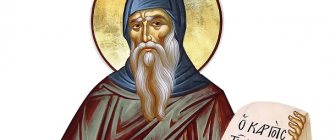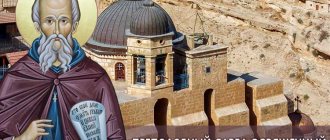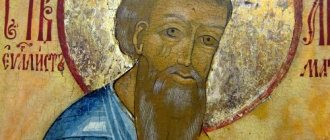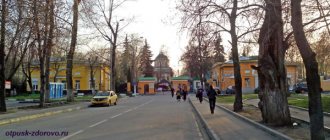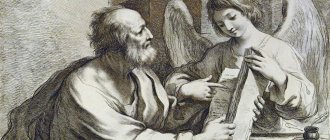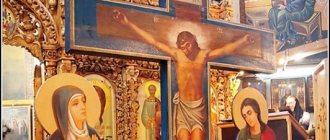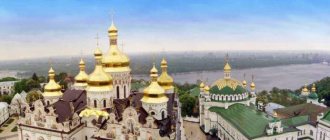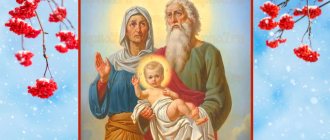A saint is called a saint who during his lifetime was a monk and did not have the rank of bishop - that is, he was not an archbishop, bishop, metropolitan or patriarch.
The most famous saints in the Russian Church:
- Venerable Seraphim of Sarov
- Venerable Ambrose of Optina
- Venerable Sergius of Radonezh
The most famous saints of the Russian and foreign Churches who lived in the 20th century:
- Venerable Silouan of Athos
- Venerable Paisius the Svyatogorets
- Rev. Seraphim Vyritsky
Elder Silouan of Athos is one of the most famous holy ascetics of the 20th century. A monk who was honored to contemplate the Uncreated Light already on earth.
Reverend - means that the life of this saint primarily symbolizes a deep path of prayer - similar to that of an angel. Their feat was prayer, and contact with the outside world occurred only in the flow of life, and not out of “duty”, which is implied by any priesthood or bishopric (archbishops and metropolitans could be the holiest people and have the gift for the deepest prayer and feat, but in force of their rank, they somehow participated in the secular and administrative side of the Church, since they were responsible for an entire city, metropolis, or - as in the case of the Patriarch - the entire Church).
This does not mean that all the saints were hermits and did not leave the temple all day long. Life is alive, and many of them, if spiritually instructed many lay people coming to the monastery and spiritual children living in the world. Some of the saints received veneration among the people for their selfless shepherding - like the saints Seraphim of Sarov or Ambrose of Optina, to whom thousands of pilgrims flocked. And they received spiritual or physical healing from them...
Who are the saints?
Where did the need to give definitions (faces) of saints come from and who are the saints?
A saint is not only and not so much an ascetic - that is, a person who outwardly devoted himself to service, asceticism and labor not for himself, but for God. A person can be an ascetic, but not a saint.
A saint is one who has acquired the Grace of the Holy Spirit. And in which the presence of the Holy Spirit was or became obvious to those around him.
(Sometimes the understanding that a person was a saint comes after his death, and sometimes already during the person’s life it is obvious to everyone that canonization - that is, recognition of him as a saint by the entire Church - is a matter of time)
Holiness does not mean that a person was necessarily endowed with any supernatural abilities - the gift of clairvoyance or the ability to heal - although, more often than not, saints discovered incredible Gifts in themselves. Nor does it mean that every seer is a saint.
The Church's canonization of one or another ascetic carries two goals:
- pay tribute to a saint;
- set an example of the path to holiness, so that everyone living on earth can find an inspiring or encouraging example for themselves.
The host of saints is a reminder of how varied the path to Heaven can be already here on earth. It's an encouraging (or sobering) reminder that you don't have to be a monk to become a saint. You don't have to be killed for Christ to become a saint. You don't have to be homeless and blessed to become a saint. The ways of the Lord are inscrutable, and holiness is determined not by the external form in which the life of this or that person has been clothed - but by his internal attitude towards life, God and Eternity.
Ancient icon of the Appearance of the Mother of God to St. Sergius of Radonezh
Reverends
The Light of Christ emanates from Holy people. Archbishop Sergius (Korolyov)
Since the birth of the Christian Church, there have been believers who fully followed the call of the Savior: “If anyone wants to come after Me, let him deny himself and take up his cross and follow Me...” These Christians left worldly life and went to secluded places where they carried feat of monastic life. On this path, many of the ascetics acquired many spiritual gifts: the gift of prayer, spiritual vision or insight, and miracles. This is how a special order of holiness arose - the venerables. These are the saints of the monks who, through prayer, fasting and labor, strived to be like the Lord Jesus Christ. In every rank of saints there are examples of achieving this likeness. Martyrs, Equal-to-the-Apostles, saints, righteous people - each in his own measure fulfilled the Lord’s commandment to strive for God-likeness. But only monks glorified by the Church bear the title of venerable. Monastic life differs from the life of all other Christians only in its special, more intense striving towards God. The laity sought in monasteries real evidence of the Divine light illuminating man. And having found this holiness, they compared monastic service with angelic service at the throne of God. Most saints of the rank of venerables were glorified in Rus'. Their glory, like sunlight, spread throughout the Christian world. Believers come from all over the world to the Russian land to venerate the holy relics of St. Seraphim of Sarov, Sergius of Radonezh, Ambrose of Optina and many others. Russian history is rich in the names of great ascetics who left behind many disciples who also became great saints. It is difficult to overestimate the merits of Saints Anthony and Theodosius of Kiev-Pechersk in the development of monasticism. The Kiev-Pechersk Lavra founded by the monks became a model of holiness and piety for many other monasteries. The Orthodox compare St. Anthony, the founder of the Kiev-Pechersk Lavra, with the prophet Moses, who gave the law to the people of Israel. Just as Moses, after ascending the sacred Mount Sinai, directed his people on the path of the truth of God, Saint Anthony arrived from the holy Mount Athos to establish the law of monastic life in newly enlightened Rus'. When he arrived in Kyiv, there were already monasteries here, founded by the Greeks at the request of the Russian princes. But Anthony did not choose any of them, but settled in a cave, where he performed the exploits of a strict monastic life. His food was black bread and water in very small quantities. When his fame spread throughout many Russian cities, disciples began to come to him, among whom was the Monk Theodosius. Once in the temple he heard the words of the Savior: “Whoever loves father or mother more than Me is unworthy of Me.” And then Theodosius left his hometown and came to Kyiv to the Monk Anthony. After the number of Saint Anthony's disciples reached twelve, he withdrew to a cave in a nearby mountain and began to carry out ascetic labors in seclusion. Then the brethren of the new monastery elected Theodosius as their abbot, who was also their spiritual leader. In addition to his ascetic deeds, the Monk Theodosius was distinguished by his great mercy towards the poor and love for spiritual enlightenment. He left teachings to the monks, the people, messages to the Grand Duke Izyaslav and two prayers. The power of prayer and deeds of the Pechersk saints amazed both contemporaries and subsequent generations of believers. Many of the monks became missionaries, preaching Christianity in areas where paganism existed. The Monk Sergius of Radonezh has been revered as the abbot of the Russian Land for more than six hundred years. The monk received such a high title for his great concern for the salvation of the Orthodox who turned to him both during his earthly life and after his blessed death. Even before his birth, the Lord gave Mary, the saint’s mother, a sign that the future great saint was in her womb. During the Divine Liturgy, the baby cried out three times while in the womb. The priest who baptized the baby, Father Michael, predicted that “he will be the chosen vessel of God, the abode and servant of the Holy Trinity.” The first of the Russian saints, the Monk Sergius was honored with the appearance of the Mother of God and a miraculous vision, which was a prophecy about the monastery he founded. Seeing an extraordinary light and many beautiful birds, the monk heard a heavenly voice: “Sergius! You pray for your children, and your prayer is heard: so the number of your disciples will increase, and after you it will not become scarce...” The monastery of St. Sergius in the Name of the Most Holy Trinity was and remains the heart of Russian Orthodoxy. As amazing as the life of its founder, Saint Sergius, is, so rich is the history of this famous monastery, which reflects the entire history of Russia. On the eve of his repose, the great saint of God called the brethren for the last time and addressed the words of his testament: “Take heed to yourselves, brethren. First have the fear of God, spiritual purity and unfeigned love...”
Saints are our prayer books and patrons in heaven. br /> Archpriest Sergius Bulgakov
What kind of saints are there?
Here are some of the most famous faces of saints.
The apostles are:
Disciples of Jesus Christ. There were not twelve of them, but much more, although twelve of them were considered His closest Disciples. Moreover, the word “apostle” itself is not equivalent to the word “saint,” since Judas was also and is called an apostle, but it was he who betrayed Christ...
The four Gospels were written by the apostles: Matthew, Mark, Luke and John.
The faithful are:
Such a face was awarded to monarchs or princes who, instead of strengthening their earthly power, tried to strengthen Christian faith and piety both in themselves and around them, and this is what they unconditionally put in first place in their lives. For example, the holy noble prince Daniel of Moscow. In his honor there is a monastery of St. Danilov in Moscow.
The blessed ones (they are also the holy fools) are:
Saints who have taken the path of outwardly looking like a madman, a homeless person, a fool and an eccentric. Perhaps this is one of the most difficult feats to explain, and in any case it was not their “choice”, but a Calling...
With their lives, they caused ridicule from others on the one hand (and thus, in the end, they achieved holy humility), and on the other hand, many of them helped to see spiritually (or simply helped) the poor, the orphans, and those who really need help . For example, Blessed Ksenia of St. Petersburg.
An icon of Saint Blessed Xenia of Petersburg, who took upon herself the feat of foolishness after the sudden death of her husband.
Martyrs are:
- Those who gave their lives for faith and Christ.
- Great martyrs are those who endured especially difficult trials and torment.
- Hieromartyrs are priests (monks or non-monks) killed for their faith.
- Venerable martyrs are slain saints.
- New martyrs - those who fell in the persecution of the Church in the 20th century. Basically, we are talking about post-revolutionary Russia and Stalin’s repressions.
Reverends are:
We talked about this in detail at the beginning. Reverends are saints who were monks in earthly life, but did not receive the rank of bishop: that is, by calling they had a life similar to angels.
Equal to the Apostles are:
Saints, thanks to whom a large number of people were baptized or believed - that is, whose feat was equal to that of the apostles. For example, Saint Nicholas of Japan, who at the beginning of the 20th century baptized thousands of Japanese, was canonized among the Equal-to-the-Apostles - an absolute miracle, given the mentality of this people and its rootedness in traditions.
The saints are:
Saints who were priests or monastic bishops during their lifetime.
Passion-bearers are:
Saints who were killed not for faith (that is, for a call to renounce it or from Christ), but for keeping the Commandments or for the very idea of \u200b\u200bpiety. For example, Emperor Nicholas II.
Miracle Workers are:
None of the saints sought supernatural abilities for themselves; most were even burdened by them. However, the Lord is generous to people of holy life, and the path of some of them for the Church and the people is associated primarily with miracles: clairvoyance, healings... And in prayers they are addressed with special hope - to miraculously change the existing state of affairs: disorder, illness, personal weaknesses.
In Russia, for example, St. Nicholas the Wonderworker is especially revered.
Rare photo: Venerable Elder Paisiy Svyatogorets feeding a bird.
Prayers
Troparion to the One Saint, general
In you, father, it is known that you were saved in the image: / for you accepted the cross, you followed Christ, / and you taught in action to despise the flesh, for it passes away, / to be diligent about the souls, things that are immortal. / In the same way, the angels rejoice, Reverend [name of rivers], your spirit
.
Troparion to the Saints, general
God our father, / always deal with us according to Your meekness, / do not forsake Your mercy from us, / but through their prayers / guide our life in peace
.
Troparion to the venerable wife, general
In you, mother, it is known that you were saved, even in the image: / having accepted the cross, you followed Christ, / and in action you taught to despise the flesh, for it passes away; / be diligent about souls, things more immortal; / In the same way, O holy [name of the rivers], your spirit will rejoice with the angels.
Troparion to the Venerable Wives, general
Unfazed by the true desire, Christ-glorifying, / and a temporary betrothed, rejecting copulation, / and having grown through virtuous deeds, / to the height of the eastern incorruptibility, / red-hearted and much rich, / pillars of monastic wives and the rule: / pray for us in the same way, / celebrating your memory with love
.
Theological basis of the concept
The concept of “venerable” is directly related to the core meaning of Orthodox hagiology - the doctrine of likeness to God, deification (theosis (ancient Greek θέωσις pronounced - téosis) from θεός “God”).
As is clear from the name, “venerable” is a saint who has been likened to God in the extremely high sense of the word, that is, who has become closely similar to God, who has become “god by grace.” The doctrine of deification significantly distinguishes Orthodox Christianity from other Abrahamic monotheistic traditions (Islam and Judaism). The doctrine of deification was formed during the first millennium of Christian history mainly in the monastic environment and received its final form in the theology of St. Gregory Palamas and his students in the 14th century. The possibility of theosis is based on the idea of imitation of God, one of the first mentions of which we find in St. apologist Aristides of Athens2. And one of the first non-biblical references to the fundamental possibility of Christians becoming “gods” is the phrase of Tertullian in his treatise “Against Hermogenes”: “We can even become gods if we are worthy of being those about whom He announced: “I said: you are gods, and God became in the assembly of the gods" (Ps. 81:6)"3. The doctrine of deification is based on the Holy Scriptures of the Old Testament and is an integral and central part of Christian doctrine. According to St. Athanasius the Great: “God became man so that man might become deified.”
Thus, a reverend is a person who, during his lifetime, took the path of imitation of God, the path of becoming like God, in order to become a god “by grace.” The expression “God by grace” refers to the hesychast tradition of Orthodox asceticism, which testified that deification occurs with the active participation of man himself, in synergy, collaboration with God, through the closest union with Him. A possible sign of deification was and is considered to be the contemplation of Divine energies by a person. The result of such a spiritually grace-filled union is the state of “God by grace,” a person’s “reverence” to God.
Literature
- Karpov A.
Orthodox saints and miracle workers. Ancient Rus'. Moscow Rus'. Russian empire. - Moscow: Veche, 2005. - Ostanina S.P.
Saints and miracle workers. Brief biographical dictionary. — Ripol Classic. — ISBN 5-7905-2366-8. - Orthodox church calendar. 2013. - Moscow: Publishing House of the Moscow Patriarchate of the Russian Orthodox Church, 2012.
- Rev. // Explanatory dictionary of the living Great Russian language: in 4 volumes / author's compilation. V. I. Dal. — 2nd ed. - St. Petersburg. : Printing house of M. O. Wolf, 1880-1882.
| Faces of holiness in Orthodoxy |
| Apostle | Unmercenary | Blessed | Blessed | Godfather | Great Martyr | Confessor | Martyr | Righteous | Forefather | Venerable Martyr | Reverend | Reverend Confessor | Prophet | Equal to the Apostles | Saint | Priest Confessor | Hieromartyr | Stylite | Passion-bearer | Miracle Worker | Holy Fool |
Notes
- [interpretive.ru/dictionary/445/word/prepodobnyi Rev.] V. Zhivov. Holiness. A brief dictionary of hagiographic terms
- ↑ 1234
[www.zakonbozhiy.ru/Zakon_Bozhij/Chast_1_O_vere_i_zhizni_hristianskoj/Prepodobnye/ Reverends] website “The Law of God” - The word “reverend,” according to Dahl’s dictionary, means, firstly, “very similar, similar” (Dahl, 1880-1882). Meanings such as “holy, righteous, saint” or “monk” and, in general, one “to whom the honor of reverence is given,” apparently developed from the first meaning and denote the similarity with Christ of the person to whom the title of reverend is applied.
- [days.pravoslavie.ru/Life/life221.htm St. Paul of Thebes] on the website Pravoslavie.Ru
- [days.pravoslavie.ru/Life/life1070.htm St. Pachomius the Great] on the website Pravoslavie.Ru
- [days.pravoslavie.ru/Life/life6434.htm St. Anthony the Great] on the website Pravoslavie.Ru
- [days.pravoslavie.ru/Life/life4561.htm Venerable Hilarion the Great] on the website Pravoslavie.Ru
- [days.pravoslavie.ru/Life/life6584.htm St. Ephraim the Syrian] on the website Pravoslavie.Ru
- [days.pravoslavie.ru/Life/life6843.htm Venerable Simeon the Stylite] on the website Pravoslavie.Ru
- [days.pravoslavie.ru/Life/life754.htm Venerable Mary of Egypt] on the website Pravoslavie.Ru
- [days.pravoslavie.ru/Life/life6816.htm Reverend Savva the Sanctified] on the website Pravoslavie.Ru
- [days.pravoslavie.ru/Life/life736.htm Venerable John Climacus] on the website Pravoslavie.Ru
- [pilgrims.in.ua/ru/top-svyatyni/st-zverinets.html History of Zverinetsky Caves]
- Nikon Rozhdestvensky, Archbishop
, “The Life and Deeds of the Venerable Sergius of Radonezh” (the full version of the title is “The Life, Miracles and Deeds of the Venerable and God-Bearing Father Sergius, Abbot of Radonezh and the Wonderworker of All Russia”), Trifonov Pechenga Monastery, “Ark”, Moscow, 2003, pp. 405–422. - Nikon Rozhdestvensky, Archbishop, “The Life and Deeds of the Venerable Sergius of Radonezh” (the full version of the title is “The Life, Miracles and Deeds of the Venerable and God-Bearing Father Sergius, Abbot of Radonezh and the Wonderworker of All Russia”), Trifonov Pechenga Monastery, “Ark”, Moscow, 2003, pp. 416–417.
- [temples.ru/card.php?ID=11788 Church of St. Seraphim of Sarov at the Moscow Research Institute of Pediatrics and Pediatric Surgery, registration card] Website [temples.ru/index.php Temples of Russia]

